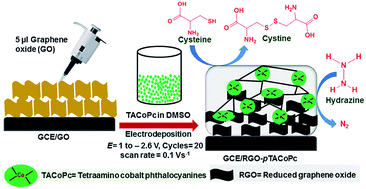Electropolymerization of cobalt tetraamino-phthalocyanine at reduced graphene oxide for electrochemical determination of cysteine and hydrazine†
Abstract
We describe a simple and elegant electropolymerization method to prepare highly stable tetraamino functionalized cobalt phthalocyanine (pTACoPc) at electrochemically reduced graphene oxide (RGO). The described method efficiently bridges the excellent physicochemical properties of RGO with the rich redox chemistry of TACoPc. Graphene oxide was electrochemically reduced to RGO at the electrode surface along with concominent electropolymerization of TACoPc. The electrochemical studies showed that RGO on pTACoP/GCE increased effective surface area, reduced charge transfer resistance and enhanced electrochemical signal. The RGO-pTACoPc film modified electrode exhibits excellent electrocatalytic ability to oxidize cysteine and hydrazine. To determine cysteine, the RGO-pTACoPc sensor displayed a linear concentration range of 50 nM to 2.0 μM, detection limit of 18.5 nM and sensitivity of 10.19 nA nM−1 cm−2. Besides, the sensor displayed a linear concentration range of 50 nM to 2.6 μM, detection limit of 10 nM and sensitivity of 1.62 nA nM−1 cm−2 to determine hydrazine. The electrocatalytic ability of RGO-pTACoPc shows better performance over other cobalt phthalocyanine derivatives. Furthermore, the described sensor exhibited long-term storage stability, good repeatability and reproducibility. The practical applicability of the sensor has been assessed in biological and water samples.


 Please wait while we load your content...
Please wait while we load your content...